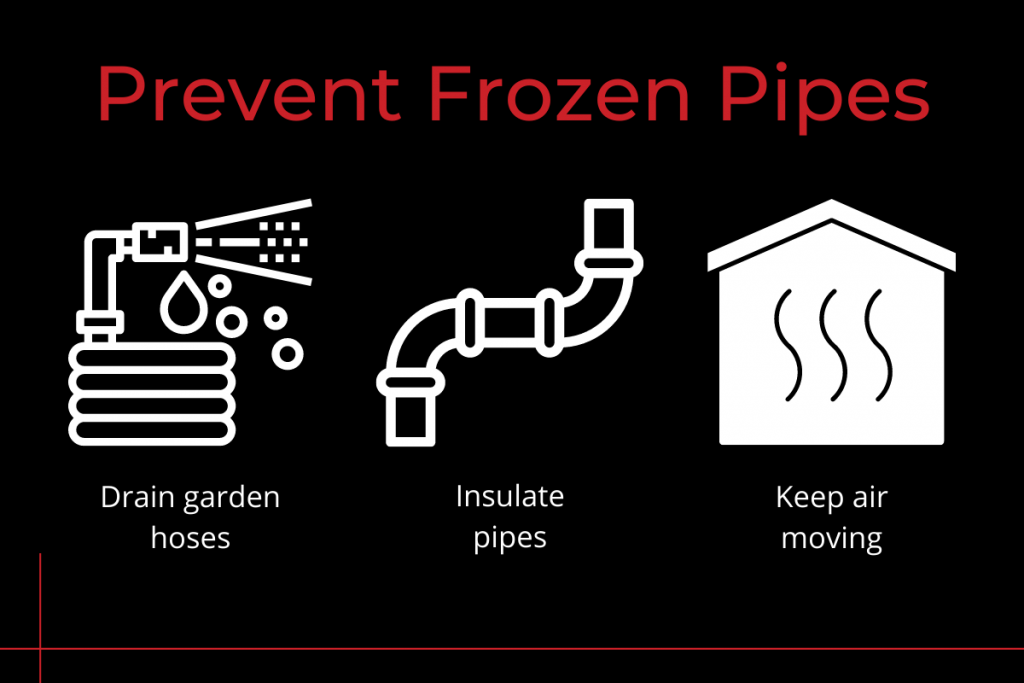It’s never too late – or too early – to prepare your home for the winter. Falling leaves, plunging temperatures, and winter storms can cause issues for homeowners, so be sure to take time to get ready for winter now. With some planning, you can minimize damages to your home as well as save money on heating bills by taking several proactive home maintenance steps. Follow these few steps to prepare your home for winter.
Keep the Cold Air Out & the Warm Air In
One of the best and easiest ways to help reduce your heating costs over the winter months is to find ways to keep the cold air out, and the warm air in. The best news is this is something you can most likely do yourself, with minimal financial investment. Take a weekend to inspect your home to find the most common sources of air leaks including:
- Window frames: Windows are a prime cause of air leaks in a home. You can seal air leaks on window frames by applying caulk around the perimeter. Use caulk for gaps that are less than ¼ inch wide. The US Department of Energy recommends applying caulk when the temperature is above 45 degrees, so make plans now to address leaky window frames.
- Door frames: Doors are another source of access for cold air. An easy way to check for leaks around a door frame is to light a candle on a windy, brisk day and move the candle around the perimeter of the closed door. The flame will flicker in areas where the air is leaking through the door. To fix this issue, you can use caulk on the door frame, or you can invest in weather stripping from your local hardware store. Weatherstripping comes in different forms including V Strip (also known as tension seal), felt, foam tape and door sweeps, and tubular rubber, vinyl, or silicone.
- Electrical outlets: Many homeowners overlook electrical outlets when searching for sources of cold air in their homes. Electrical outlet plates should be flush with the walls prohibiting air from entering the main living areas of the home. Consider adding foam or caulk into gaps around flush-mounted electrical boxes and behind electrical cover plates. When choosing the caulk or foam for this project, be sure to look for products that are fire blocking.
Not only will these home maintenance projects keep away the chill, but they will also help you realize energy savings during the winter months.
Trim Trees
Fall is a beautiful time in our region with the trees turning bright colors. Trees can also be troublesome this time of year, as branches can weaken and fall on to properties. Check your trees to make sure they are healthy and strong – larger trees near your home should be trimmed back, especially if they are hovering near your roof. Fallen trees are an issue during winter snow and ice storms, and cause millions in damages to homeowners each year.
Prevent Frozen Pipes
Frozen pipes can be a nightmare for homeowners. They can burst and cause flooding and water damage, which could lead to costly repairs. There are several ways to prevent frozen pipes in your home including:
- Drain garden hoses: There was a huge increase in the number of people working on summer gardens in 2020. If you were one of the many to join the trend, be sure to drain and remove garden hoses before temperatures plunge during the winter. In addition, shut off the water valve to external spigots and use a foam covering to create an air pocket around the spigot.
- Add insulation: Exposed water pipes may benefit from the addition of insulation. Products like pipe sleeves, heat tape, and heat cable can be applied to pipes to keep water temperature above freezing.
- Keep air warm and moving: During a cold snap, open kitchen and bathroom cabinets to allow warmer air from living spaces to flow in and around plumbing. If you are leaving your home for an extended period of time, you may be tempted to turn off your heat system, but don’t. Indoor air temperatures of unoccupied spaces should be set at a minimum of 55 degrees to ward off frozen pipes.
Learn About Our Residential Restoration Services
Check Your Home’s Heating and AC Systems
Before the weather turns cold, take time to perform routine maintenance on your heating and air conditioning systems. At the very minimum, change all air filters. Dirt in an air filter can obstruct airflow which makes both heating and AC units work harder to regulate the indoor air temperature. This can cause higher electricity bills. For heating systems specifically, consider engaging your local HVAC company to perform yearly maintenance to ensure the system is working properly. Now is the time to discover any issues before freezing temperatures arrive.
Hot water heaters should also be inspected and checked for efficiency. Old hot water heaters can potentially burst causing flooding and headaches for homeowners.
Prepare Now. Save Later.
Preparing your home for winter may feel like an unnecessary task, however, taking a few steps now can prevent floods and other damages to your home. While we hope you don’t need us this fall and winter, we can help should your home experience damages from cold weather. Reynolds Restoration Services has been helping home and business owners restore their property to its pre-loss condition after a flood, storm, or fire for more than 15 years. With offices in Harrisburg and Philadelphia, PA and Baltimore, MD, our teams can respond quickly and are on-call 24/7.

President of Reynolds Restoration Services. Over 20 years of experience in the emergency restoration industry.


